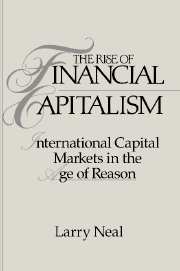Book contents
- Frontmatter
- Contents
- Acknowledgments
- 1 Historical background for the rise of financial capitalism: commercial revolution, rise of nation-states, and capital markets
- 2 The development of an information network and the international capital market of London and Amsterdam
- 3 The early capital markets of London and Amsterdam
- 4 The Banque Royale and the South Sea Company: how the bubbles began
- 5 The Bank of England and the South Sea Company: how the bubbles ended
- 6 The English and Dutch East Indies companies: how the East was won
- 7 The integration of the English and Dutch capital markets in peace and war
- 8 The English and Dutch capital markets in panics
- 9 The capital markets during revolutions, war, and peace
- 10 A tale of two revolutions: international capital flows, 1792–1815
- 11 The Amsterdam and London stock markets, 1800–25
- Appendix End-of-month share prices
- Bibliography
- Index
5 - The Bank of England and the South Sea Company: how the bubbles ended
Published online by Cambridge University Press: 25 March 2010
- Frontmatter
- Contents
- Acknowledgments
- 1 Historical background for the rise of financial capitalism: commercial revolution, rise of nation-states, and capital markets
- 2 The development of an information network and the international capital market of London and Amsterdam
- 3 The early capital markets of London and Amsterdam
- 4 The Banque Royale and the South Sea Company: how the bubbles began
- 5 The Bank of England and the South Sea Company: how the bubbles ended
- 6 The English and Dutch East Indies companies: how the East was won
- 7 The integration of the English and Dutch capital markets in peace and war
- 8 The English and Dutch capital markets in panics
- 9 The capital markets during revolutions, war, and peace
- 10 A tale of two revolutions: international capital flows, 1792–1815
- 11 The Amsterdam and London stock markets, 1800–25
- Appendix End-of-month share prices
- Bibliography
- Index
Summary
Adam Anderson's detailed description of the events of the South Sea Bubble has remained the authoritative source for all subsequent analysis of this fascinating episode at the dawn of financial capitalism. Anderson's theme was simply that an inner ring of the South Sea directors had bribed the government into allowing them to hoodwink the holders of the existing government debt. That was the immediate, politically palatable, verdict reached as well by Robert Walpole. Because of his leadership in the financial reconstruction that followed the collapse of the bubble, Walpole became prime minister, and his term of office (1720–42) remains the longest in British history. All subsequent historians have echoed his verdict, with minor variations of emphasis on the political intrigues of the time, general corruption in the government and the society, the peculiar nature of the South Sea Company, or the infections from international speculative fevers.
It is clear that the South Sea episode included a swindle by a subset of the directors of the company, as well as widespread bribes to high officials, court favorites, and members of Parliament that were in some cases quite large. It is not clear, however, that swindling and bribery were the primary elements in the situation. Although the directors of the company were fined severely, all of their estates being expropriated save for the £5,000 to £10,000 capital necessary for an eighteenth-century London gentleman, the company retained its charter, the government debt exchanged from South Sea stock remained converted, and foreign investors who had been attracted to the London stock market during the bubble continued to invest in English securities on a much larger scale after the end of the bubble.
- Type
- Chapter
- Information
- The Rise of Financial CapitalismInternational Capital Markets in the Age of Reason, pp. 89 - 117Publisher: Cambridge University PressPrint publication year: 1991



